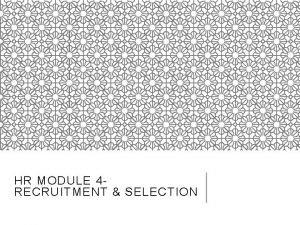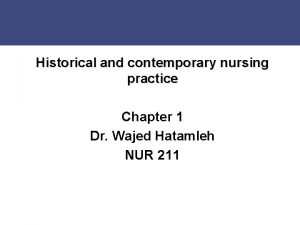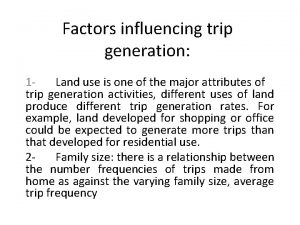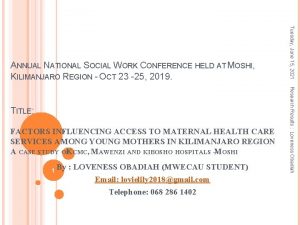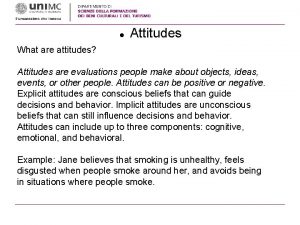Factors Influencing Womens View and Attitudes toward Midwifery






























- Slides: 30

Factors Influencing Women`s View and Attitudes toward Midwifery Profession: Tool Validation Mrs Omymah Al-Rajabi Nurse Educator Rufaida College for Nursing , Midwifery & Paramedical Dr. Lourance Al-Hadid Assistant professor Faculty of Nursing Al Isra University

Background • Midwifery is a growing profession the public usually have limited knowledge of its roles and scope. • lack of knowledge influences public views of and attitudes toward the profession. • This is especially true among women who receive midwifery care.

Background Several factors that influence public view and attitudes toward midwifery have been reported in literature including The adoption of abstract theory that constructs midwifery scope of practice Mass media reflections of midwives Personal characteristics and practice of midwives General attributes of midwives as viewed by women, and how midwives treat women ethically.

Background Major challenges faced midwives in their work such as competition with other maternal expertise, such as gynecologists, to prove their competencies in the maternal field Persuading the public with midwives roles as independent practitioners, leaders, counselors, educators, advocators, and partners to women

Background Women in literature reflected controversial views and limited knowledge about the midwifery profession in different countries around the world. limited knowledge in Jordan on factors that influence women views and attitudes toward the profession and roles of midwives was found.

International definition of midwives " Are professional health care practitioner who offer primary care to healthy women and their normal unborn and new born babies through out normal pregnancy , labor , birth , postpartum , the neonatal and inter-conceptional periods“ (Medical Board of California , 2005)

International definition of midwives “Are independent women's health practitioners who provide care across the life span , focusing particularly on pregnancy , child birth , the post partum period, care of the new born , and the family planning and gynecologic needs of women’’ (American College of Nurse-Midwives, 2003)

Midwifery In Jordan There are shortage in midwives; 3. 44 midwives for 10000 population (MOH statistics, 2010). The midwives practice primary role at MCH centers: Family Planning Counseling Inserting 25% of intra uterine device Caring for half post natal women Giving birth for 81% normal deliveries at governmental hospitals

Purpose of the study Validate a new composite tool that explores factors influencing women views & attitudes toward midwives and midwifery profession in Jordan.

Methods Design • A descriptive, cross-sectional, quantitative research design was used. • Data were collected between January and April 2012.

Participants 526 women from maternity and maternal child health centers, anti, in-labor, and post units Participant received midwifery care from different health sectors, including the private, the public and the military sectors.

Study Sampling Two steps in choosing the sample: Firstly, cluster sampling whereby three clusters were identified (north, middle, and the south)to represent different regions in Jordan. Ten Jordanian cities were chosen. Secondly, the sample included a convenience, purposive sample of pregnant women aged 18 -50 year-old.

Statistical analysis Data analyses by using SPSS version 19. Both descriptive and inferential stats. Exploratory factor analysis and normality tests.

Statistical analysis Item loadings greater or equal to the cut-off point of. 40. The internal consistency and reliability of the scale were calculated using Cronbach’s alpha, Guttman Split-Half and Spearman-Brown measures.

Instrument development Extensive LR to find how the concept of ‘factors influencing public/women view and attitudes toward midwifery’ had been used in existing instruments and in instruments closely related. There was hardly any instrument providing a reliable and accurate measure that served the purpose of the study. So, the researchers decided to develop a new instrument. .

Development of the content validity Involved three steps. Firstly The following terms (SPERATELY AND IN MESH) were used as the initial search criteria: ‘professionalism’, ‘attitudes’, ‘midwifery profession’, and ‘standards of midwifery care’. Further searches were conducted on the names of authors of research articles initially found in the first search, as well as on the key terms of their studies

Secondly Thematic analysis of the retrieved. Themes were examined, grouped and categorized. These groups were transformed next into statements reflecting their meanings each under its underlying general theme to formulate a questionnaire. The questionnaire consisted of the following themes: women general view towards midwives' duties, professional ethics, media role, qualification of midwife, de-motivating professional factors. Experts in midwifery were then consulted for the comprehensive representation of themes. Finally, by consensus, agreement on themes and items that assess women views and attitudes toward midwifery adequately.

Thirdly The questionnaire was reviewed to evaluate their relevance by using a self-administered questionnaire submitted to 6 experienced midwives. They were asked about relevance, content and coherence of the items. No changes were introduced on the 43 items

Fourthly Pilot testing on 15 women; Cronbach’s alpha value was. 918. While women had no problems responding to the items, they suggested some changes for greater clarity and 8 items were reworded. This 43 -items scale was then used for subsequent data collection on the whole sample.

Factor analysis An EFA was performed on the original 6 factors. The items that loaded significantly were 29 and 5 factors. The first 6 items explained more than 57% of the total variance (Eigen values were equal or more than 1). The Kaiser–Meyer–Olkin Measure was 0. 914; acceptable level of intercorrelation among the items. Bartlett’s test of sphericity showed that the correlations between the items were sufficient to perform factor analysis, approximate Chi-Square of 6106. 95 (p =. 000).

Figure 1. The Cattell’s Scree plot test

Reliability and Normality Cronbach’s alpha for the 29 -item scale was 0. 900. Cronbach’s alpha values of the factors ranged from 0. 871 to 0. 886. Spearman-Brown coefficient was 0. 848, 0. 849 for equal and unequal length respectively. Guttman Split Half coefficient was 0. 844, indicating an acceptable item correlation. The 5 factors correlations ranged from 0. 815 to 0. 839.

Figure 2. Q-Q probability plot of the participants’ scores on the questionnaire The Q-Q plot shows scores very close to normal line indicating scores close to normal distribution

Findings Demographic Data

Factor Category N (%) Age 17 -25 26 -35 36 -45 >45 School Diploma Baccalaureate Graduate degree Housewife Health professional Teacher Others 1. 000 2. 00 3. 00 4. 00 and more City Village Suburbs Bedouin 100 (19%) 240 (45. 6%) 154 (29. 3%) 32 (6. 1%) 229 (43. 5%) 191 (36. 3%) 92 (17. 5%) 14 (2. 7%) 306 (58. 2%) 93 (17. 7%) 61 (11. 6%) 66 (12. 5%) 68 (12. 9%) 82 (15. 6%) 98 (18. 6%) 278 (52. 9%) 315 (59. 9%) 120 (22. 8%) 79 (15%) 12 (2. 3%) Education Job Number of births Residence

Table 2. Internal consistency, item loadings and mean scores values No. Factors and descriptors Means Loadings 1 2 3 4 5 Women General View of The Midwife (α: . 777, Mean Score: 3. 0768) Appreciation 3. 45. 732 Follow-up 2. 94. 658 Delivery 3. 15. 592 Restfulness 3. 46. 590 Salary 2. 40. 523 Midwife Duties (α: . 871, Mean Score: 2. 9561) 1 2 3 4 5 6 Home Birth Availability Caring Education Teaching Psychological Preparation 1. 64 3. 41 2. 99 3. 06 3. 14 3. 01 . 802. 777. 756. 749. 685. 587 7 Family Participation 2. 94 . 557 8 Referral 3. 36 . 535 9 Receiving First 3. 21 . 473

10 11 Family Planning 3. 13 . 460 Documentation 329 . 417 Professional Ethics (α: . 857, Mean Score: 2. 9561) 1 2 3 4 5 6 7 8 Respect to Culture and Beliefs 2. 89 . 719 Privacy and Safety 3. 23 . 687 Respect During Labor 2. 91 . 682 Partnership 2. 74 . 681 Psychological Support 2. 90 . 611 Respect of Choice 2. 76 . 600 Confidentiality 3. 17 . 558 Error Reporting 2. 72 . 552 Media Role (α: . 669, Mean Score: 3. 3517) 1 2 Physician Authority 3. 34 . 769 Old-Aged, Traditional 3. 36 . 665 De-Motivating Professional Factors (α: . 798, Mean Score: 2. 9943) 1 2 3 Long Working Hours 3. 35 . 820 Night Duties 3. 40 . 769 Embarrassment 2. 24 . 539

Findings Women don’t consider midwifery as a preferable profession for their daughters because of the discussed de-motivating factors Women lack understanding about midwifery profession such as exposing to hospital acquired infections, career advancement, only they know that midwife is giving birth to women. Women lack awareness about midwife qualification

Conclusions The instrument is valid and reliable. it needs further use in other studies to confirm findings in this study and determine the stability of the instrument. There is a need to develop public policies that address these factors so that better understanding of midwifery profession in the public can be promoted and positive attitudes will be established.

Recommendations Increase Academic level of midwives. Adopting evidence-based practice. Addressing media and present good examples from the profession. Developing standards of care and provide continuing education to midwives to promote the profession advancement.
 How did mughal attitudes and policies toward
How did mughal attitudes and policies toward Rowan plan formula
Rowan plan formula 3 factors that affect recruitment and selection
3 factors that affect recruitment and selection Differences between men's and women's soccer
Differences between men's and women's soccer Parental attitude meaning
Parental attitude meaning Factors influencing chemical weathering
Factors influencing chemical weathering Physical factors influencing agriculture
Physical factors influencing agriculture How to compute the displacement
How to compute the displacement Contemporary nursing practice meaning
Contemporary nursing practice meaning Factors influencing trip attraction
Factors influencing trip attraction Pricing policy
Pricing policy A model of destination image formation
A model of destination image formation Factors that influence communication process
Factors that influence communication process Factors influencing maternal health
Factors influencing maternal health Systemic factors that affect wound healing
Systemic factors that affect wound healing Factors influencing faculty staff relationship
Factors influencing faculty staff relationship Explain the objective of plant layout
Explain the objective of plant layout Facility decisions
Facility decisions Physical factors influencing agriculture
Physical factors influencing agriculture Factors affecting consensus
Factors affecting consensus Types of chemical weathering
Types of chemical weathering Factors influencing distribution network
Factors influencing distribution network Factors affecting oxygenation
Factors affecting oxygenation Physical factors influencing agriculture
Physical factors influencing agriculture Basic carburetor diagram
Basic carburetor diagram Factors influencing t&d
Factors influencing t&d Differentiated learning theories
Differentiated learning theories Ph partition theory
Ph partition theory Factors of altruism
Factors of altruism Factors influencing distribution network design
Factors influencing distribution network design Factors influencing compensation philosophy
Factors influencing compensation philosophy


